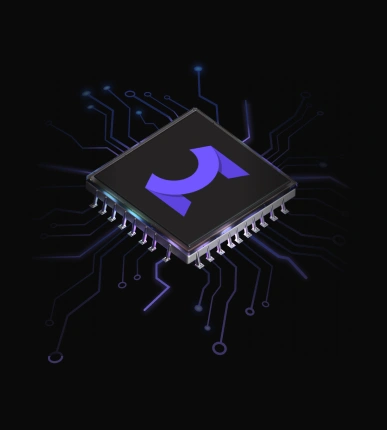- Published: 2025-07-16
- Updated: 2025-10-14
- Dmitry Lambin
Fusion 360 Alternative for Mesh Simplification
The moment has come to take another step in our journey of exploring mesh simplification. Now we turn our attention to Autodesk Fusion 360. The mesh simplification potential made available by it might turn this tool into a noteworthy contender. As usual, we will test its performance simultaneously with MeshLib to find out what promises better results (to access extra details of our research, click here).
Mesh Simplification via Autodesk Fusion 360 and MeshLib: Procedure Overview
Meet our good old Nefertiti. This mesh is both pleasant to look at and challenging to process, as it contains 2+ million triangles. Thus, it could be a hard nut to crack for technically inadequate tools.
Chosen Mesh to Simplify
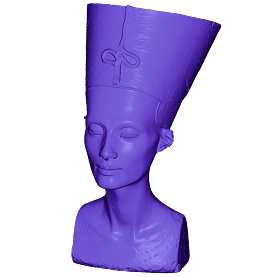
Research Conditions for Mesh Simplification
Mesh simplification demands vary widely, pertaining to your one-of-a-kind use case. In some workflows, reducing complexity by a factor of 10 would suffice. In others, reductions by 100 or even 1,000 times might become inevitable. Our intention is to propose assessing the capabilities of chosen toolboxes through two key benchmarks:
Benchmark 1. Heavy Simplification
The objective is to start with 2 million triangles down and get just to 2,000, which is a dramatic complexity reduction.
Benchmark 2. Moderate Simplification
This involves a less aggressive ambition, simplifying the same 2 million triangles to 200,000—a tenfold decrease. As it seems to us, these two tests constitute a robust evaluation framework.
- Regarding the touchstones we rely on to compare our contestants, there are seven in total:
- Time — represents the real-world duration spent on completing the task, measured in seconds.
- Degeneracies — indicate the count of triangles with extreme aspect ratios, specifically those exceeding 1:100.
- Self-Intersections — denote the total count of overlapping or intersecting geometries.
- Small Components — refer to the number of isolated or disconnected mesh elements.
- Holes — represent the quantity of missing or absent geometries in the mesh.
- Hausdorff Distance (mm) — is the maximum deviation between the original and simplified meshes.
- Average Absolute Distance (mm) — describes the average difference, providing a comprehensive measure of geometric accuracy.
Our Contenders: MeshLib featuring ST/MT versus Autodesk Fusion 360 Adaptive/Uniform
Don’t get surprised when you see four images in our galleries and four rows in our tables below. On the one hand, we are experimenting with two options. However, each reveals two different ways to operate.
What do ST and MT mean with MeshLib?
- ST is for Single-Threaded. This simplification mode leverages the capabilities of a single CPU core.
- MT is for Multi-Threaded. As it is already clear, this mode of ours harnesses multiple threads, taken together, at the same moment of time. For our evaluation efforts, we conducted our tests on a machine with 16 cores.
Keep in mind: Whenever building upon MT, make sure the number of threads aligns with your system’s power, supported by a decent number of cores. For example, applying 64 threads on a 16-core machine would be inefficient, even wasteful. Whereas 16 threads for 16 cores is totally alright.
What is with Autodesk Fusion Adaptive and Uniform?
In Autodesk Fusion 360, adaptive and uniform refer to two distinct methods of reducing the number of faces in a mesh:
- Adaptive Mesh Simplification modifies the density of the mesh based on local surface complexity. Areas with sharp details, intricate curvature, or high geometric complexity get a finer mesh (e.g., smaller triangles, more of them), while flatter or less complex regions receive fewer and larger triangles. By doing this, adaptive simplification preserves critical details where needed but reduces the overall face count significantly in less critical areas;
- Uniform Mesh Simplification, just as the name implies, strives for consistency in triangle size throughout the entire model. Unlike adaptive methods, it does not selectively adjust mesh density based on curvature or detail. Instead, it applies a uniform mesh size to the whole part. This uniform approach ensures a consistent triangle distribution, which could be beneficial in scenarios where uniformity and predictability matter more than localized detail retention.
Note: While uniform simplification ensures consistency, it may unnecessarily increase triangle density in simple regions or reduce detail in more complex areas.
Test Mission: Heavy Mesh Simplification
To support our conclusions, we are sharing the results of our work right away.

MeshLib ST
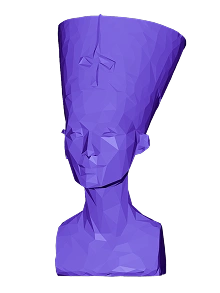
MeshLib MT

Autodesk Fusion 360 Adaptive

Autodesk Fusion 360 Uniform
As you can see, with Autodesk Fusion 360, our Queen of Ancient Egypt is hardly recognizable. This is not without reason, as figures below will prove.
Digest
Touchstone | ST | MT | Autodesk Fusion
360 Adaptive | Autodesk Fusion
360 Uniform |
|---|---|---|---|---|
Task Time(s) | 3.9 | 0.9 | 12 | 11 |
Degeneracies (strong, i.e., 1:100, see explanation below) | 0 | 0 | – | – |
Self-Intersections | 0 | 0 | – | – |
Small Components | 0 | 0 | – | – |
Holes | 0 | 0 | – | – |
Hausdorff Distance (mm) | 3.45 | 3.286 | – | – |
Average absolute distance (mm) | 0.287 | 0.284 | – | – |
Heavy Mesh Simplification Mission Accomplished?
Figures confirm your initial assumptions based on the visuals above. While MeshLib delivers adequate quality in heavy mesh simplification, Autodesk’s performance is well beyond criticism—there are no satisfactory quality parameters to report, as this alternative completely failed the heavy mesh simplification test.
Test Mission: Moderate Mesh Simplification
Once again, let’s kick things off with a visual demonstration
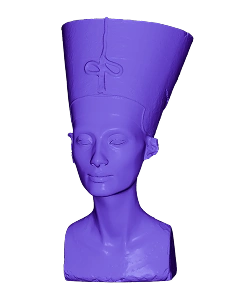
MeshLib ST
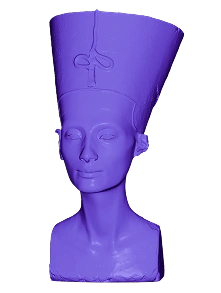
MeshLib MT
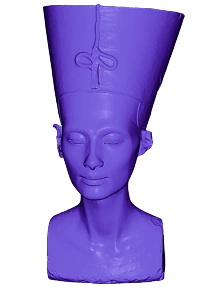
Autodesk Fusion 360 Adaptive
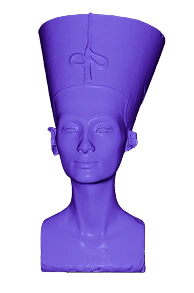
Autodesk Fusion 360 Uniform
MeshLib fully rose to the occasion. In addition to that, the deliverables generated by Autodesk Fusion 360 look much better. The output retains the recognizability of the original model: for all intents and purposes, both images look fine. Time to look closer at the details.
Digest
Touchstone | ST | MT | Autodesk Fusion 360 Adaptive | Autodesk Fusion 360 Uniform |
|---|---|---|---|---|
Task Time(s) | 3.8 | 0.9 | 12 | 12 |
Degeneracies (strong, i.e., 1:100, see explanation below) | 0 | 0 | 650 | 280 |
Self-Intersections | 3 | 0 | 80 | 30 |
Small Components | 0 | 0 | 0 | 0 |
Holes | 0 | 0 | 0 | 0 |
Hausdorff Distance (mm) | 0.143 | 0.143 | 0.402 | 1.252 |
Average absolute distance (mm) | 0.018 | 0.018 | 0.034 | 0.034 |
Moderate Mesh Simplification Mission Accomplished?
When it comes to moderate mesh simplification, MeshLib outperformed Autodesk Fusion 360. Both the ST and MT modes demonstrated higher precision rates with minimal degeneracies, no self-intersections, and zero holes or small components. With significantly shorter task times and better exactness, MeshLib proved not only swifter but also more dependable.
However, it is worth noting that Autodesk Fusion 360 also produced deliverables without holes or small components. The job was completed without catastrophic errors. Thus, Autodesk Fusion 360 could still serve you as a viable tool if the slight quality trade-offs and higher task times are acceptable in the given context.
Conclusion
When your heavy simplification success is at stake, Autodesk Fusion 360 should be avoided outright. The tool is simply unable to generate any valuable results. In contrast, MeshLib handles heavy simplification properly.
For moderate simplification scenarios, Autodesk Fusion 360 becomes a more reasonable alternative. MeshLib still outperforms it in terms of precision, efficiency, and overall quality. However, Autodesk can produce usable outcomes without catastrophic errors. The output will not match MeshLib’s level, but it may suffice for projects where certain imperfections are acceptable.
What our customers say
Thomas Tong
Founder, Polyga

Gal Cohen
CTO, customed.ai

Mariusz Hermansdorfer
Head of Computational Design at Henning Larsen Architechts

HeonJae Cho, DDS, MSD, PhD
Chief Executive Officer, 3DONS INC

Ruedger Rubbert
Chief Technology Officer, Brius Technologies Inc








Start Your Journey with MeshLib
MeshLib SDK offers multiple ways to dive in — from live technical demos to full application trials and hands-on SDK access. No complicated setups or hidden steps. Just the tools you need to start building smarter, faster, and better.
